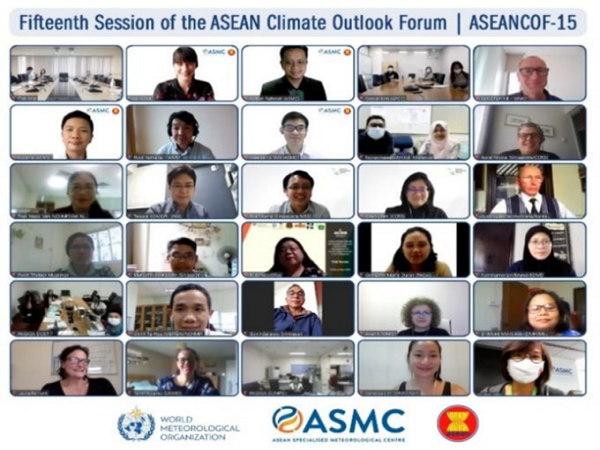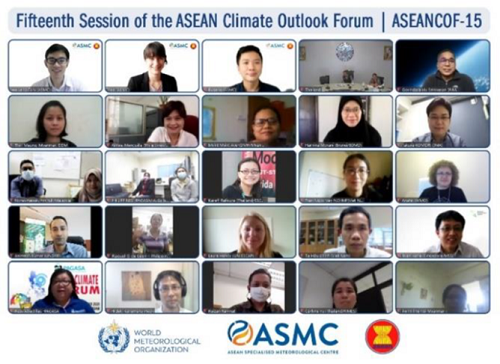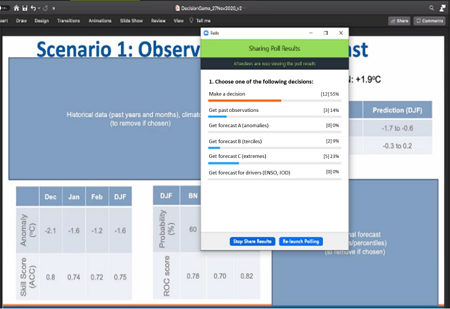18 MAR 2021
ASEANCOF
Summary of the Fifteen Session of the ASEAN Climate Outlook Forum (Online, Singapore)

Some participants from the first day of ASEANCOF-15.
Introduction
The 15th Session of the ASEAN Climate Outlook Forum (ASEANCOF-15), coordinated by ASMC, took place online over three days in November 2020. It was attended by over 50 participants from ASEAN Member States’ National Meteorological and Hydrological Services (NMHSs), the World Meteorological Organization (WMO), WMO Global Producing Centres (GPCs), other global centres, and representatives from the disaster risk reduction sector. While the November session normally takes place as a physical meeting, due to COVID-19 and the associated travel restrictions, the meeting was held online.
Day 1 and Day 2
The first day of ASEANCOF-15 covered presentations from the NMHSs and GPCs for the December 2020 – February 2021 season. Making use of the online format, there were presentations not only from the ASEAN region, but also from as far away as Australia and Europe. The common thread through all the presentations was the La Niña conditions that had developed in the second half of 2020. These presentations, and subsequent discussions, formed the basis of the regional consensus discussions that followed.
The focus of the second day was to arrive at the regional consensus for climate drivers as well as the rainfall and temperature outlook. There was also an objective review of the previous outlook, made possible by the new format for the ASEANCOF outlook implemented in May 2020. Additionally, presentations on the SEA RCC-Network and moving towards objective outlooks also took place on the second day. Ryan Kang (Executive Meteorologist, Meteorological Service Singapore) gave an overview of the new SEA RCC-Network and Long-range Forecasting Node pages, and polled the audience on potential new features for the website (the Standardised Precipitation Index was the most popular choice as a new product to be included on the website). Wilfran Moufouma-Okia (Head, Climate Prediction Services Division, WMO) highlighted the steps to make a Regional Climate Outlook Forum (RCOF) more objective and noted how ASEANCOF was a good candidate for implementing these changes.
Day 3
The final day of the forum focussed on the disaster risk reduction sector, as well as the dissemination of the consensus outlook for the upcoming season. For this day, additional participants from the disaster risk reduction sector joined in, including national representatives from Myanmar, Thailand and the Philippines.
Some participants from the final day of ASEANCOF-15.
The final day started with an interactive game led by Tan Wee Leng (Research Scientist, ASMC). Participants were tasked to decide on their mitigation strategy for a forecast potential disaster. For this task, they had a limited timeframe for mitigation measures to be put in place. Individual participants were given the option to access various pieces of information in order to decide on what action to be taken as part of their mitigation plan. Upon deciding that they were ready to make this decision, individual participants were able to initiate a consensus poll; the final action taken by the group was decided by polling all participants. During the game, participants could request for climate and weather information. However, accessing such information would incur a time penalty and leave less time for their final decision. Ultimately, most players requested for ENSO as well as tercile and anomaly forecasts — common products used in seasonal outlooks. Whether they succeeded in mitigating the disaster (or not), the overall feedback from the participants on this session was favourable.
Screenshot of the interactive game used as part of ASEANCOF-15. Through engagement with participants, the game aimed to increase their understanding of possible decision-making processes for disaster preparedness
Following the game and the presentation of the consensus forecast, representatives from the United Nations Economic and Social Commission for Asia and the Pacific (UN ESCAP), the Regional Integrated Multi-Hazard Early Warning System for Africa and Asia (RIMES), and the Food and Agriculture Organization of the United Nations (FAO) shared their experiences working in disaster risk reduction. The participants were then broken into groups to further discuss how climate outlooks could support disaster risk reduction in Southeast Asia.
Conclusion
Overall, ASEANCOF-15 demonstrated that the many aspects of physical ASEANCOF meetings could be translated to an online platform. While there were fewer opportunities for interaction amongst participants as compared to the usual physical meetings, there were more opportunities for people to join with the forum as it had been held virtually.
The ASEANCOF Consensus Statement for DJF 2020-2021 can be found here.